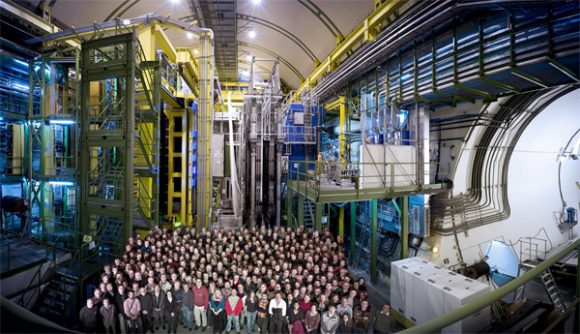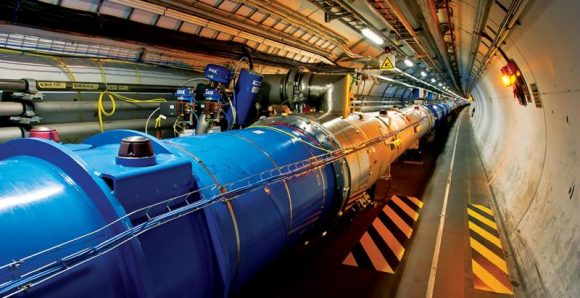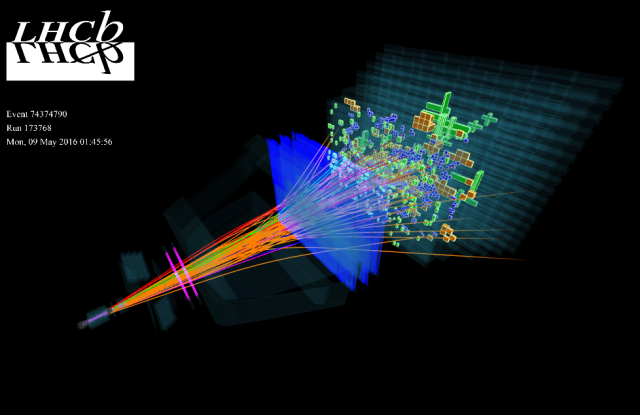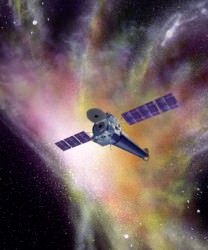Since it began its second operational run in 2015, the Large Hadron Collider has been doing some pretty interesting things. For example, starting in 2016, researchers at CERN began using the collide to conduct the Large Hadron Collider beauty experiment (LHCb). This is investigation seeks to determine what it is that took place after the Big Bang so that matter was able to survive and create the Universe that we know today.
In the past few months, the experiment has yielded some impressive results, such as the measurement of a very rare form of particle decay and evidence of a new manifestation of matter-antimatter asymmetry. And most recently, the researchers behind LHCb have announced the discovery of a new system of five particles, all of which were observed in a single analysis.
According to the research paper, which appeared in arXiv on March 14th, 2017, the particles that were detected were excited states of what is known as a “Omega-c-zero” baryon. Like other particles of its kind, the Omega-c-zero is made up of three quarks – two of which are “strange” while the third is a “charm” quark. The existence of this baryon was confirmed in 1994. Since then, researchers at CERN have sought to determine if there were heavier versions.

And now, thanks to the LHCb experiment, it appears that they have found them. The key was to examine the trajectories and the energy left in the detector by particles in their final configuration and trace them back to their original state. Basically, Omega-c-zero particles decay via the strong force into another type of baryon (Xi-c-plus) and then via the weak force into protons, kaons, and pions.
From this, the researchers were able to determine that what they were seeing were Omega-c-zero particles at different energy states (i.e. of different sizes and masses). Expressed in megaelectronvolts (MeV), these particles have masses of 3000, 3050, 3066, 3090 and 3119 MeV, respectively. This discovery was rather unique, since it involved the detection of five higher energy states of a particle at the same time.
This was made possible thanks to the specialized capabilities of the LHCb detector and the large dataset that was accumulated from the first and second runs of the LHC – which ran from 2009 to 2013, and since 2015, respectively. Armed with the right equipment and experience, the researchers were able to identify the particles with an overwhelming level of certainty, ruling out the possibility that it was a statistical fluke in the data.
The discovery is also expected to shed light on some of the deeper mysteries of subatomic particles, like how the three constituent quarks are bound inside a baryon by the “strong force” – i.e. the fundamental force that is responsible for holding the insides of atoms together. Another mystery that this could help resolve in the correlation between different quark states.

As Dr Greig Cowan – a researcher from the University of Edinburgh who works on the LHCb experiment at Cern’s LHC – explained in an interview with the BBC:
“This is a striking discovery that will shed light on how quarks bind together. It may have implications not only to better understand protons and neutrons, but also more exotic multi-quark states, such as pentaquarks and tetraquarks.“
The next step will be to determine the quantum numbers of these new particles (the numbers used to identify the properties of a specific particle) as well as determining their theoretical significance. Since it came online, the LHC has been helping to confirm the Standard Model of particle physics, as well as reaching beyond it to explore the greater unknowns of how the Universe came to be, and how the fundamental forces that govern it fit together.
In the end, the discovery of these five new particles could be a crucial step along the road towards a Theory of Everything (ToE), or just another piece in the very big puzzle that is our existence. Stay tuned to see which!




